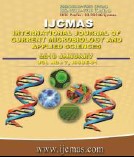


 National Academy of Agricultural Sciences (NAAS)
National Academy of Agricultural Sciences (NAAS)

|
PRINT ISSN : 2319-7692
Online ISSN : 2319-7706 Issues : 12 per year Publisher : Excellent Publishers Email : editorijcmas@gmail.com / submit@ijcmas.com Editor-in-chief: Dr.M.Prakash Index Copernicus ICV 2018: 95.39 NAAS RATING 2020: 5.38 |
Rice is an important versatile food crops which feeds over half of the world's population and provides essential food elements, employment opportunity as well as raw materials for different products used by human kind. An investigation was carried out with the twenty six genotypes of rice to study the nature and magnitude of genetic divergence using D2 statistics in 2015. Eleven quantitative traits were recorded on the genotypes raised in the RBD Design with three replications. The twenty six genotypes were grouped into six clusters based on Euclidean cluster analysis with cluster I containing the maximum of 11 genotypes. Maximum intra-cluster distance was observed in cluster III indicating greater genetic divergence between the genotypes belonging to this cluster. The cluster IV having highest average compared to other five groups in terms of seven traits. Maximum inter-cluster distance was recorded between cluster III and IV followed by cluster I and VI indicating wide genetic diversity and it may be used in rice hybridization programme for improving grain yield. The maximum contribution of individual trait to the divergence among genotypes recorded in number of spikelet per panicle. Thus, these genotypes hold great promise as parents for obtaining promising elite lines through hybridization and to create further variability for these characters.
 |
 |
 |
 |
 |